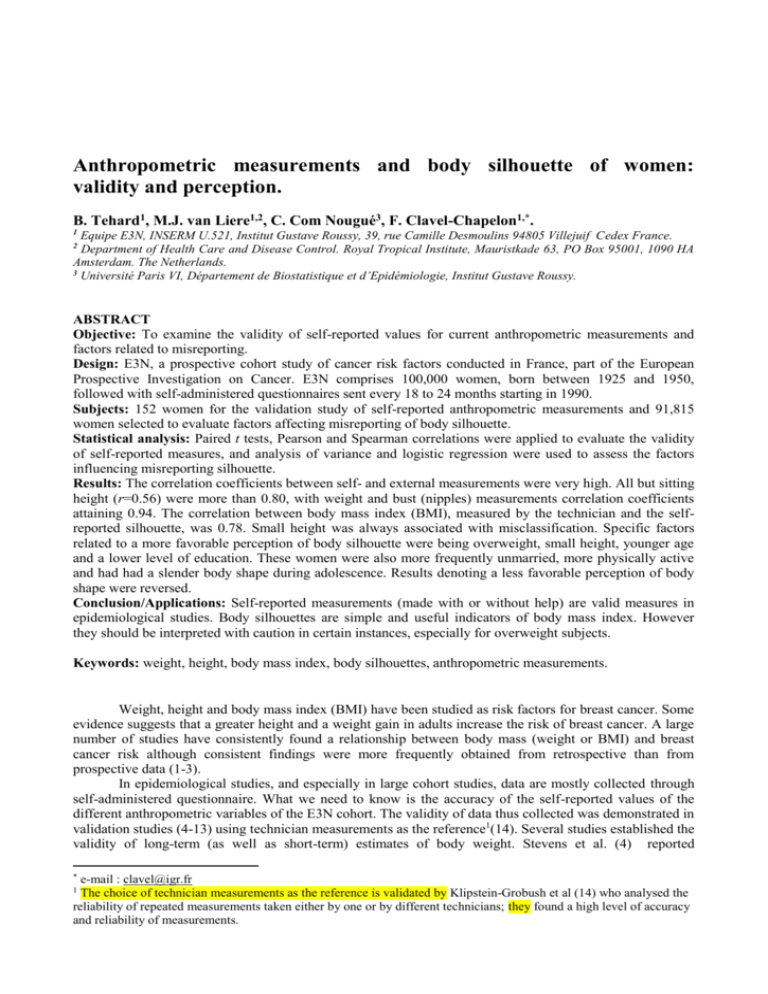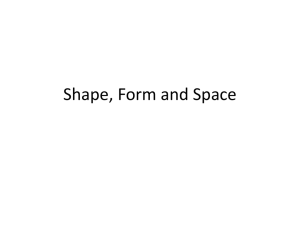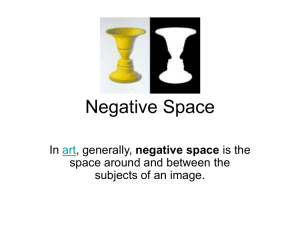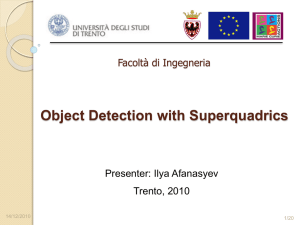Anthropometric measurements and body Silhouette - HAL
advertisement

Anthropometric measurements and body silhouette of women: validity and perception. B. Tehard1, M.J. van Liere1,2, C. Com Nougué3, F. Clavel-Chapelon1,*. 1 Equipe E3N, INSERM U.521, Institut Gustave Roussy, 39, rue Camille Desmoulins 94805 Villejuif Cedex France. Department of Health Care and Disease Control. Royal Tropical Institute, Mauristkade 63, PO Box 95001, 1090 HA Amsterdam. The Netherlands. 3 Université Paris VI, Département de Biostatistique et d’Epidémiologie, Institut Gustave Roussy. 2 ABSTRACT Objective: To examine the validity of self-reported values for current anthropometric measurements and factors related to misreporting. Design: E3N, a prospective cohort study of cancer risk factors conducted in France, part of the European Prospective Investigation on Cancer. E3N comprises 100,000 women, born between 1925 and 1950, followed with self-administered questionnaires sent every 18 to 24 months starting in 1990. Subjects: 152 women for the validation study of self-reported anthropometric measurements and 91,815 women selected to evaluate factors affecting misreporting of body silhouette. Statistical analysis: Paired t tests, Pearson and Spearman correlations were applied to evaluate the validity of self-reported measures, and analysis of variance and logistic regression were used to assess the factors influencing misreporting silhouette. Results: The correlation coefficients between self- and external measurements were very high. All but sitting height (r=0.56) were more than 0.80, with weight and bust (nipples) measurements correlation coefficients attaining 0.94. The correlation between body mass index (BMI), measured by the technician and the selfreported silhouette, was 0.78. Small height was always associated with misclassification. Specific factors related to a more favorable perception of body silhouette were being overweight, small height, younger age and a lower level of education. These women were also more frequently unmarried, more physically active and had had a slender body shape during adolescence. Results denoting a less favorable perception of body shape were reversed. Conclusion/Applications: Self-reported measurements (made with or without help) are valid measures in epidemiological studies. Body silhouettes are simple and useful indicators of body mass index. However they should be interpreted with caution in certain instances, especially for overweight subjects. Keywords: weight, height, body mass index, body silhouettes, anthropometric measurements. Weight, height and body mass index (BMI) have been studied as risk factors for breast cancer. Some evidence suggests that a greater height and a weight gain in adults increase the risk of breast cancer. A large number of studies have consistently found a relationship between body mass (weight or BMI) and breast cancer risk although consistent findings were more frequently obtained from retrospective than from prospective data (1-3). In epidemiological studies, and especially in large cohort studies, data are mostly collected through self-administered questionnaire. What we need to know is the accuracy of the self-reported values of the different anthropometric variables of the E3N cohort. The validity of data thus collected was demonstrated in validation studies (4-13) using technician measurements as the reference1(14). Several studies established the validity of long-term (as well as short-term) estimates of body weight. Stevens et al. (4) reported * e-mail : clavel@igr.fr The choice of technician measurements as the reference is validated by Klipstein-Grobush et al (14) who analysed the reliability of repeated measurements taken either by one or by different technicians; they found a high level of accuracy and reliability of measurements. 1 correlations between self-reported and measured weight attaining r=0.98 for current, r=0.94 for 4-year and r=0.82 for 28-year recall. Koprowski et al. (5) reported correlations (r=0.83) between reported and actual BMI at menarche for young adult women. Some studies (6,7) showed that obese individuals underestimate their weight whereas slender individuals overestimated it. Casey et al. (8) reported correlations between recall of past weight and measured weight, ranging from r=0.87 at 18 years to 0.95 at 40 years when 60year-old participants of the study were questioned. Manson et al. (9) found a high correlation (r=0.96) between weight measurements reported 6 to 12 months previously and current measurements. Some studies have been published on the validity of other anthropometric parameters such as sitting height, bust, hip and waist measurements by comparing self-measurements and technician measurements. The correlation attained was 0.88 for the waist and 0.89 for the hip in Freudenheim and Darrow’s study (10). Weaver et al. (11) found that the accuracy of self-reported measurements of waist, hip, chest and bust circumferences was high (Pearson correlation coefficients more than 0.93) as compared with the same measurements taken by a technician. Recalling one’s body corpulence or giving one’s past weight and height is difficult and may generate numerous missing values (12). Body silhouettes such as those introduced by Sörensen et al. (13) allow subjects to be ranked and may avoid the problem of recalling an absolute value such as weight. It is therefore easier to have access to such information. Few studies have assessed the usefulness of these body silhouettes (15-19). Must et al. (16) found high correlations between body silhouettes and measured BMI for females (0.65 at 10 years of age, 0.75 at 15 years, 0.66 at 20 years and 0.75 for current age). Mueller et al. (19) found correlations over 0.92, comparing current body silhouettes to BMI. Thompson and Gray (17) and Gardner et al. (18) criticised the optimality of Sörensen’s scale of silhouettes and Thompson and Gray (17) proposed another type of silhouette. Factors related to misclassification of anthropometric measurements have been reported in the literature and most often concerned the objective of weight loss among dieters or people suffering with eating disorders, although some studies have published data on the general population (20-22). The first objective of this study was to assess the validity of self-reported measurements of anthropometric characteristics and body silhouette (a simple measure that can be used as a surrogate for measured BMI). We therefore performed a validation study on a small sample of the E3N French cohort. The second objective, based on the whole cohort, was to test the relationship between the body silhouettes chosen by the women questioned and the BMI derived from the self-measured weight and height and to analyse factors related to misclassification of the self-reported body silhouettes. MATERIAL AND METHODS. E3N is a prospective cohort study on cancer risk factors conducted in France and is part of the European Prospective Investigation on Cancer, (EPIC) (23). E3N includes 100,000 women, born between 1925 and 1950, living in France, and insured by a national health insurance plan (MGEN), that mostly covers teachers. The main objective of the study was to investigate relationships between diet and cancer and between hormonal treatments and cancer. The occurrence of cancer and of other diseases (cardiovascular diseases, diabetes and osteoporosis) is recorded prospectively. Participants were entered into the study between June 1990 and November 1991 when they replied to a baseline questionnaire, in which they had to indicate their current weight, height and body silhouettes (Figure). Follow-up questionnaires were sent every 18 to 24 months thereafter. All questionnaires were self-administered. 1 Fig. 2 3 4 5 6 7 8 Body silhouettes shown in the baseline questionnaire (as first proposed by Sörensen et al. 13) First a validation study was done on a sample of the E3N cohort (186 subjects) who had volunteered to give blood for the biological sample bank. All the 186 women participants were from the Paris center of the E3N cohort as this was more convenient. The day before their appointment at the study center, women had to complete a self-administered questionnaire, reporting their weight, height, sitting height, hip, waist and bust circumferences and body silhouette. All values were self-reported measurements that women completed with or without help (38% of our participants were assisted for measurements of their sitting height). A skilled technician took the same measurements, with standardised devices. Height and sitting height were measured with the SECA height gauge. Weight was measured with the SECA electronic scales, and all the anthropometric circumferences were measured with a tape measure. The technician also evaluated each woman’s body silhouette. The 152 women (82%) who completed the questionnaire represent the validation study sample. Technician measurements were used as the “gold standard” to assess the validity of self-measurements made by study sample participants. We then studied factors concerning reported silhouettes that differed from those expected, based on the 91,815 women in the E3N cohort who had answered the baseline questionnaire. We first had to determine what the expected, unbiased silhouette of each woman. We used the distribution of the silhouettes estimated by technicians in the validation sample of 152 women. Technicians had to choose between the 8 silhouettes of the scale. When they determined that a woman had to be classified between two adjacent silhouettes they chose the mean of the two silhouettes. No woman of the validation sample had a silhouette over 7, so we decided to create the category “over6”. We sorted the 91,815 women of the cohort by increasing BMI. and obtained theoretical limits corresponding to each silhouette. We were thus able to obtain an expected silhouette for each woman that could be compared to the one indicated in the baseline questionnaire. Then we fitted the distribution of silhouettes given by technicians to the cohort and obtained an “expected” silhouette to each woman. We compared this “expected” silhouette to the one reported by the women at the baseline. For the 11,607 women chose two adjacent silhouettes, we allocated the mean between the chosen silhouettes. We classified a woman’s self-reported silhouette as “realistic” when the difference between the two silhouettes was between –1 and 1. Others were declared “higher” if the expected silhouette was greater than the reported one, and “lower” in the other case. Statistical analysis First, to validate our data set of anthropometric measurements, we used two statistics to compare measurements made by the 152 women with the ones made by the technicians: the Student’s paired t test and Pearson correlation. The first statistic evaluated the likelihood of a constant bias of women selfmeasurements by comparing both means. The second statistic evaluated the linearity of the relationship between self-measurements and technicians’ measurements (24). Body silhouettes were classified from 1 to 8 (from the thinnest to the heaviest). Pearson correlation coefficients were used to compare BMI and body silhouettes distributions and to compare the distribution of silhouettes chosen by technicians and by women. On the whole cohort, the relationship between self-measured BMI and body silhouettes was analysed with an analysis of variance for multiple comparisons. We then computed odds-ratios (OR) of the frequency of the “higher” and of the “lower” women as compared with the “realistic” women for each of the indicators studied. Two logistic regressions using the same control group, were used to obtain adjusted OR estimates together with 95% confidence intervals. In both regressions, the reference was the “realistic” women who were compared with “higher” women and then to their “lower” counterparts. Terms for the educational level, year of birth, weight, height, marital status, body silhouette at menarche, physical activity level and dietary factors were included in the regressions. Statistical analysis were performed with SAS (Release 6.12; SAS Institute, Cary, NC). RESULTS First we compared the validation sample to the whole cohort (results not presented). All 152 women in the validation study had volunteered to have a blood sample drawn for the biological sample bank in the Paris center. There was no difference observed in age. Their education had lasted longer and they had higher incomes (P<.001). They were more frequently single (P<.02). Validation study (152 subjects). No significant differences were observed between self-reported and technicians-measured mean values for weight, height and BMI (Table 1). Significant differences (P<.05) were observed between selfreported and technician’s mean values for sitting height, hip and bust (nipples) measurements. No difference exceeded 1.1 centimetre. For all continuous variables (except for body silhouettes), the correlation coefficients between selfreported and technician measurements were between 0.56, for sitting height, and 0.94, for weight and bust (nipples). All the correlation coefficients statistically differed from zero. The correlation coefficients were very high for weight, height and BMI (0.89, 0.94 and 0.92 respectively). The relations between self-reported and technician measurements were almost linear for these parameters. The average body drawing was between image 3 and 4, for both the self- and technician evaluations, and the absolute difference between the two measurements was one drawing or less for 90% of the subjects. Correlation coefficients between body silhouette and BMI vary from 0.77 for self measurements to 0.87 for technicians’ measurements; both differed significantly from zero. These correlations showed a real positive and linear trend between BMI and body silhouettes. Table 1. Relation between anthropometric parameters, as measured by subjects themselves and as measured by a skilled technician (N=152). Anthropometric measurements N Measurements by Pb Correlation coefficientc Subject Technician Mean ± Sd Mean ± Sd Weight (kg) 150 61.9 ± 10.4 61.7 ± 10.4 NS 0.94 Height (cm) 150 161.4 ± 6.4 161.0 ± 6.1 NS 0.89 Sitting Height (cm) 128 84.2 ± 11.5 85.3 ± 3.6 <.01 0.56 Hip Circumference (cm) 151 97.7 ± 9.8 98.7 ± 8.2 <.01 0.90 Waist Circumference (cm) 150 77.7 ± 10.6 77.1 ± 10.3 NS 0.79 Bust Circumference (base) (cm) 149 81.0 ± 7.2 81.5 ± 7.6 NS 0.83 Bust Circumference (nipples) (cm) 149 94.0 ± 8.2 93.4 ± 8.4 <.05 0.94 BMId 149 23.81 ± 3.8 23.79 ± 3.8 NS 0.92 Silhouette 151 3.65 ± 1.1 3.46 ± 1.1 <.05 0.85 a SD= standard deviation p value: Student’s t-test for paired samples: H0: means are equal. c Pearson correlation coefficient: H0: the correlation coefficients are equal to zero. All correlations were significantly different from zero (p-value < 0.0001). d BMI defined as weight (kg)/height (m2). b Self-administered questionnaire (91,815 subjects). The respective mean BMIs (calculation based on the whole cohort) of each expected silhouette from the thinnest to the largest were 16.4, 18.7, 21.3, 24.1, 26.0 and 30.3 and 37.4 for the category “over 6”(only mean for exact silhouette are shown). The value of each category was significantly different from that of other category (P < .0001). We studied the factors related to a woman’s missperception of her own silhouette. Overall, 93.1% of women had a realistic perception of their silhouette (Table 2). Misclassification increased with increasing size of silhouette and small height. The logistic regression (Table 3) showed that women who considered their body silhouette favourably were heavier, shorter, younger and had a lower level of education than women with a more realistic perception of their body image. They were also more frequently unmarried, more physically active and had had a slender body silhouette during adolescence. Results denoting a “lower” perception of body silhouette were reversed. Table 2. Repartition of the misclassification of the observed silhouette, according to the “Expected” silhouette, for the women of the E3N cohort (n=91,815). “Expected” N Lower Realistic Higher body silhouette N % N % N % 1 632 24 3.8 608 96.2 0 0.0 1.5b 1,259 98 7.8 1,161 96.2 0 0.0 2 6,991 67 1.0 6,867 98.2 57 0.8 2.5 8,405 182 2.2 7,899 94.0 324 3.8 3 34,509 532 1.5 33,677 97.6 300 0.9 3.5 9,733 432 4.4 9,014 92.6 287 3.0 4 15,024 210 1.4 14,545 96.8 269 1.8 4.5 1,049 17 1.6 890 84.8 142 13.6 5 5,925 18 0.3 5,255 88.7 652 11.0 5.5 3,233 27 0.8 2,033 62.9 1,173 36.3 6 4,419 11 0.3 3,518 79.6 890 20.1 <6 Total a 636 91,815 0 1,618 0.0 1.8 0 85,467 0.0 93.1 636 4,730 100 5.1 Expected body silhouette was found fitting the distribution of the silhouette estimated by technicians, on the validation sample, to the whole cohort sorted by increasing BMI. b intermediate silhouettes in case of two adjacent choices. Table 3. Factors associated with a pessimistic reported silhouette from that expected according to an external reference. Realistica Factors Lower Adjusted-ORb Higher Adjusted-ORb % (n=85,467) % (n=1,618) (95% CI) % (n=4,730) (95% CI) Education level (years) 12.5 10.0 0.86 (0.72-1.03) 25.0 1.45 (1.33-1.58) 9 70.0 69.5 1.00 63.0 1.00 10-16 17.5 20.5 1.10 (0.97-1.25) 12.0 0.94 (0.85-1.03) 17 Year of birth After 1945 31.0 22.0 1.00 23.5 1.00 1941-45 25.0 26.0 1.46 (1.27-1.69) 23.5 0.98 (0.89-1.07) 1936-40 20.5 21.0 1.47 (1.27-1.72) 21.5 0.92 (0.83-1.01) Before 1935 23.5 31.0 2.05 (1.77-2.36) 31.5 0.89 (0.81-0.97) Height (cm) 9.0 12.0 1.23 (1.03-1.46) 13.0 3.16 (2.82-3.54) 154 23.0 28.0 1.29 (1.13-1.49) 23.0 1.61 (1.47-1.76) 155-159] 35.5 31.5 1.00 34.0 1.00 160-164] 23.0 20.5 1.11 (0.96-1.28) 20.0 0.57 (0.53-0.63) 165-169] 9.5 8.0 1.23 (1.00-1.51) 10.0 0.42 (0.38-0.47) ≥ 170 Weight (kg) 33.5 35.0 1.00 1.5 1.00 54 26.0 31.0 1.09 (0.96-1.24) 6.5 1.09 (0.95-1.26) 55-59] 20.0 20.0 0.90 (0.78-1.05) 10.5 2.64 (2.32-3.01) 60-64] 11.0 9.0 0.69 (0.56-0.83) 19.5 9.67 (8.60-10.88) 65-69] 9.5 5.0 0.37 (0.29-0.48) 52.0 32.95 (29.49-36.81) ≥70 Ever married Yes 79.0 75.5 1.00 75.5 1.00 No 21.0 24.5 1.08 (0.96-1.22) 24.5 1.20 (1.11-1.29) Physical Activity Low 26.0 32.0 1.00 24.0 1.00 Moderate 25.0 26.5 0.84 (0.74-0.96) 23.5 1.15 (1.05-1.26) Reasonable 24.0 22.5 0.73 (0.64-0.84) 23.0 1.15 (1.04-1.26) High 25.0 19.0 0.60 (0.52-0.69) 29.5 1.29 (1.18-1.41) c Body Silhouette at age 8 1 56.5 45.5 1.00 60.5 1.00 2 20.0 15.5 1.01 (0.87-1.16) 18.5 0.79 (0.72-0.85) 3 13.0 14.0 1.43 (1.22-1.66) 12.5 0.67 (0.61-0.74) 4 8.0 14.5 2.54 (2.18-2.95) 6.0 0.48 (0.42-0.54) 5 2.0 6.5 4.78 (3.86-5.91) 1.5 0.45 (0.35-0.58) ≥6 0.5 4.0 11.18 (8.51-14.69) 1.0 0.64 (0.45-0.93) a Control group. b Ratio of the probability of having estimated one’s body silhouette “lower” or “higher.” c Silhouettes were coded in the upper category in case of two adjacent choices. DISCUSSION. Validation study. The results of the validation study of self-reported anthropometric measurements were quite satisfactory although a potential limitation is a lack of statistical power due to the limited number of subjects included. Nevertheless, the differences observed between the two measurements (self-reported or taken by technicians) were small and the correlation coefficients ranged from 0.8 to 0.9 except for that concerning the sitting height. No significant difference was shown for height, weight, BMI, waist and bust (nipples) circumference. Self-reported measurements for these variables may thus be considered accurate and unbiased. The relatively low correlation coefficient for sitting height was probably due to the fact that this fairly unusual measurement is not easy to obtain without help. Correlation coefficients for height and weight were comparable to those reported in other studies (4,8,9,25-27) whereas paired differences for these parameters were smaller in our study (0.4 cm and 0.2 kg) compared to 1.6 cm and 1.1 kg in the study by Stewart et al. (25), and with 0.9 cm and 2.4 kg in the study by Palta et al. (26). Jacobson and DeBock (27) found no difference for height, but found significant differences for weight and BMI for women. Moreover we found high correlation coefficients for waist and hip measurements as well as for measurement of the bust (base and nipples). These are encouraging results because they are linked to the fat distribution for women and we know that this distribution is another potential anthropometric risk factor for cancer. The relationship between body drawings and BMI is linear in shape, with differences between drawings representing about 2 or 3 units of BMI. The correlation coefficient between BMI and silhouette was similar to that of previous studies (13,16,19,28,29). Mueller et al. (19) used Sörensen’s silhouettes to compare estimates provided by two experts and one nonskilled observer. A lower correlation was observed in studies of men comparing to women, possibly because the silhouettes depicted typical female fat distribution patterns. This problem may also arise for women with an android body composition and who have an android hormonal profile that may be related to higher risk of breast cancer (30,31). Indeed, in our study, correlation between BMI and body silhouette was lower for women with a breast-to-hip ratio equal to or greater than one, than for women with a breast-to-hip ratio smaller than one (r=0.56 vs 0.73). Our study showed mean-BMI rounded values of 18, 20, 22, 24, 27 and 30 for the 7 category of selfreported silhouettes, based on data from more than 90,000 French women, ranging in age from 40 to 65 (mean age=49 years). These values are somewhat different from those reported in Mueller et al.’s study (19). The differences may be attributable to dissimilarities in interpretation due to age, gender and socioeducational or cultural references, as shown in some studies (6,20,21,32). Self-reported measurements in our study are likely to be more precise, however, because of the size of the study population and more accurate due to its homogeneity in terms of sex, age and educational level. Gardner et al. (18), however, voiced methodological concerns about the use of silhouette figures to measure body images. These concerns are related to limited response options to one of a finite number and a limited range of silhouettes (the majority of subjects selected a very small range of silhouettes). The fact that women and technicians expressed the necessity to choose adjacent silhouettes when they were unable to fit to one of the 8 silhouettes support this point. However, silhouettes are used in epidemiological studies on cancer risk factors to rank subjects and to isolate outsiders, and Sörensen’s silhouettes are the moste used one. Gardner et al (18) also emphasised that changes in size between adjacent silhouettes are not proportional. One can legitimately argue that weight is not gained uniformly in the different body regions. Self-administered questionnaire (91,815 subjects). The relatively low correlation coefficient obtained for the body silhouette in the results of the validation study prompted us to investigate which factors characterized a “higher” perception of a woman’s body image. We found that correlation coefficients between self-reported and technician measurements were higher for almost all continuous variables (height, weight, BMI), than for categorical variables. We investigated this relationship to assess whether weaker correlations could be explained by the discrete nature of the variable, or by the fact that whereas height or weight are strictly unbiased measures, self-perception of one’s silhouette is subjective and this can generate errors if women have a false self-perception (due to eating disorders, social status, social ideal of silhouettes,etc). The main problem for this investigation was undoubtedly finding a good correspondence between a given silhouette and the associated BMI, that would be adapted to a cohort of highly educated French women and that would be totally unbiased. Using the statistics calculated from the data of the validation study, we were able to perform an appropriate logistic regression analysis in which the explained variable (discrepancy in the perception of the body image between the subject and the observer) was constructed independently of the values of the variables included in the regression (in particular self-reported weight and height measurements). The sample from which the expected body silhouette was constructed may be considered as unrepresentative of the population on which the logistic regression was done. The same analysis was also done on two other sets of data. One was composed of all the women who had volunteered to have a blood sample drawn in the Paris center (na8,000) and the other, of all blood donors (na25,000). The results (data not shown) were rigorously similar, except for the variable generation, which did not differ from unity, however. Our study demonstrates that self-perception of the body silhouette was “higher” among women who were overweight. Interestingly, women who had experienced such weight problems during adolescence had a more realistic appreciation of their current body image. Previous studies have demonstrated that heavy people underestimated their size to a greater degree than women of a normal weight (6,7,33-39). Chang and Christakis (34), Niedhammer et al. (38) and Rossouw et al. (39) found that misperception of weight was linked to age and level of education. APPLICATIONS/CONCLUSION The results of our study indicate that responses to questions on anthropometric measurements provide information almost as accurate as if measurements had been done in a medical center. This represents an important gain of time and money concerning all cohort studies which base data collection on self-administered questionnaires. Body silhouettes are valuable proxy indicators for BMI, especially in situations where weight and height values cannot be obtained. However, self-assessments should be interpreted with caution in certain instances, especially for overweight subjects. Acknowledgements The authors thank all participants for providing the data, the French League against Cancer, the European Community, the 3M company, the ‘Mutuelle Générale de l’Education Nationale’ and the Institut National de la Santé et de la Recherche Médicale for their financial support for the E3N study They thank to L. Orsi for technical assistance, to MF. Rolland-Cachera for critical reading and L. Saint Ange for editing the manuscript. References 1. World Cancer Research Fund/ American Institute for Cancer research. Food, nutrition and the prevention of cancer: a global perspective. 1997. Washington 371-5. 2. Committee on Medical Aspects of Food and Nutrition Policy. Department of Health. The Stationery Office. Nutritional Aspects of the Development of Cancer. Report of the Working Group on Diet and Cancer. 1998. London 154-9.. 3. Ursin G, Longnecker MP, Haile RW and Greenland S. A meta-analysis of body mass index and risk of premenopausal breast cancer. Epidemiology 1995; 6: 137-41. 4. Stevens J, Keil JA, Waid LR, Gazes PC. Accuracy of current, 4-year and 28-year self-reported body weight in an elderly population. Am J Epidemiol 1990; 132: 1156-63. 5. Koprowski C, Coates RJ, Berbstein L. Ability of young women to recall past body size and age at menarche. Obes Res 2001; 9:478-85. 6. Leonhard ML, Barry NJ. Body image and obesity: effects of gender and weight on perceptual measures of body image. Addict Behav 1998;23:31-4. 7. Kuskowska-Wolk A, Bergstrom R, Bostrom G. Relationship between questionnaire data and medical records of height, weight and body mass index. Int J Obes Relat Metab Disord 1992;16:1-9. 8. Casey VA, Dwyer JT, Berkey CS, Coleman KA, Gardner J, Valadian I. Long-term memory of body weight and past weight satisfaction : a longitudinal follow-up study. Am J Clin Nutr 1991; 53: 1493-8. 9. Manson JE, Colditz GA, Stampfer MJ, Willett WC, Rosner B. Monson RR, Speizer FE, Hennekens CH. A prospective study of obesity and risk of coronary heart disease in women. N Engl J Med 1990; 322: 882-9. 10. Freudenheim JL, Darrow SL. Accuracy of self-measurement of body fat distribution by waist, hip, and thigh circumferences. Nutr Cancer 1991;15:179-86. 11. Weaver TW, Kushi LH, McGovern PG, Potter JD, Rich SS, King RA, Whitbeck J, Greenstein J, Sellers TA. Validation study of self-reported measures of fat distribution. Int J Obes Relat Metab Disord 1996;20:644-50. 12. Himes JH, Faricy A. Validity and reliability of self-reported stature and weight of US adolescents. Am J Human Biol 2001; 13: 255-60. 13. Sörensen TIA, Stunkard AJ, Teasdale TW and Higgins MW. The accuracy of reports of weight : children’s recall of their parents’ weights 15 years earlier. Int J Obesity 1983; 7: 115-22. 14. Klipstein-Grobusch K, Georg T, Boeing H. Interviewer variability in anthropometric measurements and estimates of body composition. Int J Epidemiol 1997;26:S174-S180. 15. de Fine Olivarius N, Andreasen AH, Loken J. Accuracy of 1-, 5- and 10-year body weight recall given in a standard questionnaire. Int J Obes 1997;21:67-71. 16. Must A, Willett WC and Dietz WH. Remote recall of childhood height, weight, and body build by elderly subjects. Am J Epidemiol 1993; 138: 56-64. 17. Thompson MA, Gray JJ. Development and validation of a new body-image assessment scale. J Personality Assessment 1995;64:258-69. 18. Gardner RM, Friedman BN, Jackson NA. Methodological concerns when using silhouettes to measure body image. Perceptual and Motor Skills 1998;86:387-95. 19. Mueller WH, Joos SK and Schull WJ. Alternative measurements of obesity : accuracy of body build images and reported weights and heights in a Mexican American sample. Int J Obesity 1985; 9: 193-200. 20. Boström G, Diderichsen F. Socioeconomic differentials in misclassification of height, weight and Body mass Index based on questionnaire data. Int J Epidemiol 1997;26:860-6. 21. Jalkanen L, Tuomilehto J, Tanskanen A, Puska P. Accuracy of self-reported weight compared to measured body weight. A population survey. Scand J Soc Med 1987;15:191-8. 22. Jeffery RW. Bias in reported body weight as a function of education, occupation, health and weight concern. Addict Behav 1996;21:217-22. 23. Clavel-Chapelon F, and the E3N group. E3N, a French cohort study on cancer risk factors. Eur J Cancer Prev 1997;6:473-8. 24. Willet WC. Nutritional Epidemiology,second edition. Oxford University Press, 1998.224-272. 25. Stewart AW, Jackson RT, Ford MA and Beaglehole R. Underestimation of relative weight by use of self-reported height and weight. Am J Epidemiol 1987; 125: 122-6. 26. Palta M, Prineas RJ, Berman R and Hannan P. Comparison of self-reported and measured height and weight. Am J Epidemiol 1982; 115: 223-30. 27. Jacobson B, DeBock DH. Comparison of Body Mass Index by self- reported versus measured height and weight. Percept Mot Skills 2001;92:128-32. 28. Hanis CL, Ferrell RE and Schull WJ. Hypertension and sources of blood pressure variability among MexicanAmericans in Star County, Texas. Int J Epidemiol 1985; 14: 231-8. 29. Parent ME, Ghadirian P and Lacroix A. Family clustering of obesity and breast cancer. Genetic Epidemiol 1996; 13: 61-78. 30. Secreto G, Zumoff B. Abnoemal production of androgens in women with breast cancer. Anticancer Res 1994;14:2113-7. 31. Bruning PF, Bonfrèr JMG, Hart AAM, Van Noord PAH, Van der Hoeven H, Collette HJA, Battermann JJ, De JongBakker M, Nooijen WJ and Waard F. Body measurements, estrogen availability and risk of human breast cancer: a case-control study. Int J Cancer 1992; 51: 14-9. 32. Cachelin FM, Striegel-Moore RH, Elder K. Realistic weight perception and body size assessment in a racially diverse community sample of dieters. Obes Res 1998;6:62-8. 33. Smith GT, Hohlstein LA, Atlas JG. Accuracy of self-reported weight: covariation with binger or restrainer status and eating disorder symptomatology. Addict Behav 1992;17:1-8. 34. Chang VW, Christakis NA. Extent and determinants of discrepancy between self-evaluations of weight status and clinical standards. J Gen Intern Med 2001;16:538-43. 35. Nawaz H, Chan W, Abdulrahman M, Larson D, Katz DL. Self-reported weight and height: implications for obesity research. Am J Prev Med 2001;20:294-8. 36. Kuczmarski MF, Kuczmarski RJ, Najjar M. Effects of age on validity of self-reported height, weight, and body mass index: findings from the Third National Health and Nutrition Examination Survey, 1988-1994. J Am Diet Assoc 2001;101:28-34. 37. Madrigal H, Sanchez-Villegas A, Martinez-Gonzalez MA, Kearney J, Gibney MJ, Irala J, Martinez JA. Underestimation of body mass index through perceived body image as compared to self-reported body mass index in the European Union. Public Health 2000;114:468-73. 38. Niedhammer I, Bugel I, Bonenfant S, Goldberg M, Leclerc A. Validity of self-reported weight and height in the French GAZEL cohort. Int J Obes Relat Metab Disord 2000;24:1111-8. 39. Rossouw K, Senekal M, Stander I. The accuracy of self-reported weight by overweight and obese women in an outpatient setting. Public Health Nutr 2001;4:19-26.








